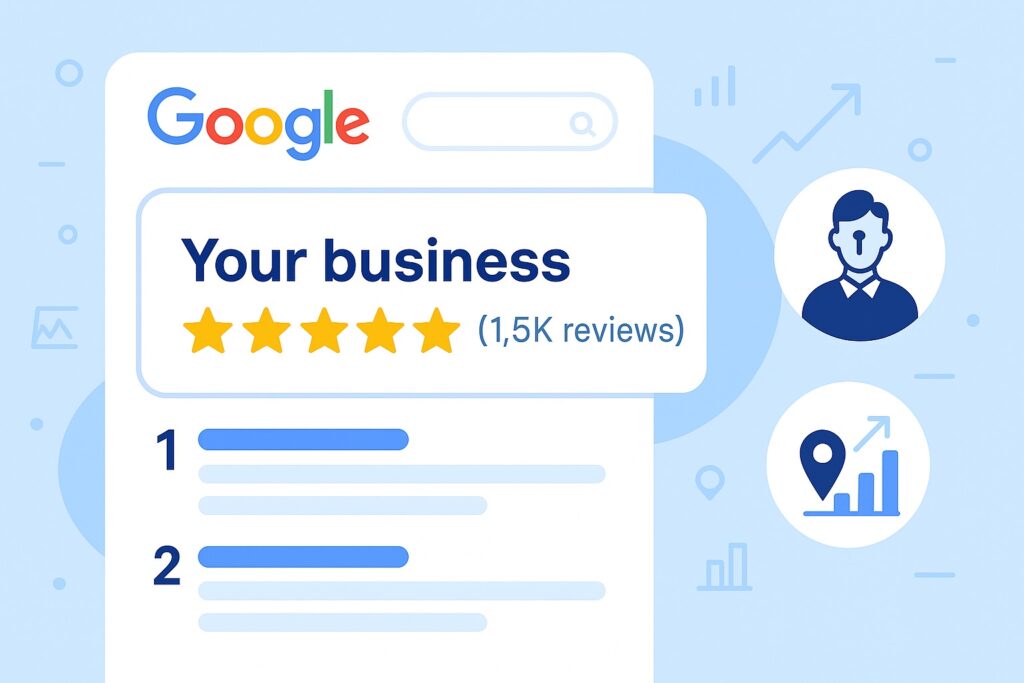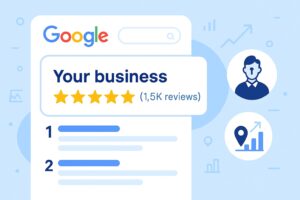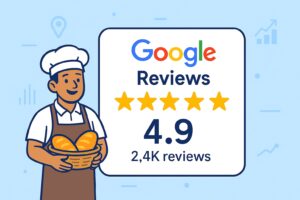
Reading Time: 7 minutes
Quick Answer: Local SEO is the practice of optimizing your online presence to attract more customers from relevant local searches. For Austin businesses, this means ensuring you appear when people search for services “near me” or in specific Austin neighborhoods. The key components are: a complete Google Business Profile, consistent business information (name, address, phone) across all platforms, local keywords on your website, positive reviews, and mobile-friendly design.
What You’ll Learn in This Article:
Over the next 7 minutes, you’ll understand exactly what local SEO means for your Austin business, learn the specific steps to rank in Google’s “Map Pack,” discover which local directories matter most, and get a 30-day action plan to improve your local visibility without hiring an expert.
Local SEO Explained Like You’re Five
Imagine Austin is a giant neighborhood, and Google is the friendly neighbor everyone asks for recommendations. When someone needs a plumber, they ask Google, “Hey, who’s a good plumber near me?”
Local SEO is making sure Google knows:
- You’re a plumber
- You’re located in Austin
- You’re trustworthy
- You’re currently in business
That’s it. No magic, no complex algorithms to decode. Just helping Google understand your business so it can recommend you to neighbors looking for your services.
Want to get listed correctly? Check out our Google Business Profile Setup Service
Why This Matters: Real Numbers from Real Austin
Let’s look at how your potential customers actually behave:
- “Near me” searches have increased 500% in recent years
- 76% of people who search for something nearby visit a business within a day
- 28% of those searches result in a purchase
What this means: Right now, someone in Austin is typing “coffee shop near me” or “emergency plumber Austin” into their phone. The question is: will they find you or your competitor?
You don’t need ads to win local traffic — just know why your Google Business Profile matters more than you think
The “Map Pack”: Your New Business Best Friend
You know when you Google something and see those three businesses pop up with a map? That’s the Map Pack, and it’s prime digital real estate.
Here’s why the Map Pack matters:
- It appears before regular search results
- It shows essential info immediately (ratings, hours, phone)
- It has a direct “Call” button
- It’s what most people click first
Getting into the Map Pack isn’t about paying Google or knowing secret tricks. It’s about proving you’re a legitimate, relevant local business.
How to Get in the Map Pack (No Bribes Required)
1. Master Your Google Business Profile
We covered this in detail earlier, but here’s the local SEO perspective:
- Complete every field (100% completion scores higher)
- Choose accurate categories (primary and secondary)
- Keep hours updated (including holidays)
- Add photos regularly (Google loves fresh content)
- Respond to reviews (shows you’re active)
2. NAP Consistency: The Foundation of Trust
NAP stands for Name, Address, Phone Number. This needs to be EXACTLY the same everywhere online.
Common NAP Mistakes:
- Bob’s AC Repair vs. Bob’s A/C Repair vs. Bobs AC Repair
- Suite 100 vs. Ste 100 vs. #100
- (512) 555-0123 vs. 512-555-0123 vs. 512.555.0123
The Fix: Pick one format and use it everywhere:
- Your website
- Google Business Profile
- Social media profiles
- Online directories
- Email signatures
3. Local Keywords Without Sounding Weird
The key is working location terms naturally into your content.
Bad Example: “We provide AC repair AC repair Austin AC repair 78701 AC repair South Austin best AC repair Austin Texas.”
Good Example: “We provide fast AC repair throughout South Austin, serving neighborhoods from 78701 to 78748.”
Natural Places for Local Keywords:
- Page titles: “AC Repair in Austin, TX | Bob’s Cooling”
- Headings: “Emergency AC Service for South Austin Homes”
- Content: “Austin’s hot summers put extra strain on your AC system…”
- Image alt text: “Bob’s AC Repair truck in downtown Austin”
Your Website: The Local SEO Foundation
Your website needs to tell both Google and customers where you are and what areas you serve.
Must-Have Pages for Local SEO:
- Homepage – Mention your location early and naturally
- Contact Page – Full address, embedded Google Map, local phone number
- Service Area Pages – “AC Repair in Hyde Park” or “Plumbing Services in East Austin”
- About Page – Your Austin story, how long you’ve served the community
The Title Tag Formula That Works:
[Service] in [City], [State] | [Business Name] | [Phone]
Example: “AC Repair in Austin, TX | Bob’s AC Service | 512-555-0123”
Content Ideas That Google (and Customers) Love
Create content that serves your local community:
Service-Based Content:
- “How Austin’s Hard Water Affects Your Plumbing”
- “Preparing Your AC for Another Scorching Austin Summer”
- “Why Cedar Fever Season Means More HVAC Maintenance”
Neighborhood Guides:
- “Common Plumbing Issues in Hyde Park’s Historic Homes”
- “Restaurant Hood Cleaning Requirements in Downtown Austin”
- “East Austin Small Business Guide: Who to Call for Repairs”
Local Resource Posts:
- “Austin Utility Rebates for Energy-Efficient AC Units”
- “City of Austin Permit Requirements for Renovations”
- “Austin Water Restrictions: What Businesses Need to Know”
The Citation Game: Building Your Online Presence
Citations are mentions of your business name, address, and phone number on other websites. Think of them as digital references that vouch for your existence.
The Big Players (Do These First):
- Google Business Profile – Obviously
- Yelp – Like it or not, it matters
- Apple Maps – Growing in importance
- Bing Places – Easy win, few businesses use it
- Facebook – Still relevant for local
- YellowPages.com – Yes, it still exists and helps
Austin-Specific Opportunities:
- Austin Chamber of Commerce – Join and get listed
- Do512 – Great for event-related businesses
- Austin Chronicle – Their business directory
- Neighborhood Facebook Groups – Not technically citations but valuable
- Local business associations – Industry-specific directories
Want a full citation audit? We’ll find every listing opportunity for you
Reviews: Your Secret Local SEO Weapon
Reviews directly impact local rankings. Here’s what Google considers:
- Quantity – More reviews generally mean higher rankings
- Recency – New reviews matter more than old ones
- Diversity – Reviews mentioning different services/aspects
- Keywords – Reviews that naturally mention your services and location
- Responses – Your engagement with reviewers
Pro Tip: When customers mention specific services or neighborhoods in reviews, it reinforces your local relevance.
Mobile Optimization: Because Everyone’s on Their Phone
Since most local searches happen on mobile devices, your site must be mobile-friendly:
Mobile Must-Haves:
- Fast loading (3 seconds maximum)
- Clickable phone number – One tap to call
- Easy-to-tap buttons – No tiny links
- Readable text – No pinching to zoom
- Working directions – Integrate with map apps
Test Your Mobile Experience:
- Google your business on your phone
- Click through to your website
- Try to call you
- Try to get directions
- If any step is frustrating, fix it
Local Link Building: Making Digital Friends
Links from other Austin websites signal to Google that you’re part of the local community.
Legitimate Local Link Opportunities:
- Sponsor local events – Get mentioned on event websites
- Join business associations – Chamber of Commerce, industry groups
- Partner with complementary businesses – Cross-promote services
- Local media features – Pitch story ideas to Austin publications
- Community involvement – Volunteer work often leads to mentions
Pitch your story to the Austin Business Journal
Track What Works: Free Tools for Monitoring Success
You can’t improve what you don’t measure. Here are free tools to track your local SEO progress:
Google Business Profile Insights:
- How customers find you
- What actions they take
- Phone calls from your listing
- Direction requests
Google Analytics:
- Traffic from local searches
- Which pages attract local visitors
- Conversion rates by location
Google Search Console:
- Which search terms bring traffic
- Your average position for searches
- Click-through rates
Common Local SEO Mistakes Austin Businesses Make
Learn from others’ failures:
- Keyword Stuffing – “Austin Austin Austin plumber Austin” doesn’t fool anyone
- Fake Addresses – Using a PO Box or virtual office will get you penalized
- Ignoring Reviews – Both good and bad reviews need responses
- Skipping Google Posts – Free visibility booster most ignore
- Ancient Website – That site from 2003 is hurting more than helping
Your 30-Day Local SEO Action Plan
Week by week, here’s how to improve your local visibility:
Week 1: Foundation
- Claim and complete Google Business Profile
- Audit NAP consistency across the web
- Add local keywords to your website homepage
Week 2: Reviews & Content
- Respond to all existing reviews
- Create review request system
- Write one local-focused blog post
Week 3: Citations & Mobile
- List business on top 5 directories
- Test website on mobile devices
- Fix any mobile issues found
Week 4: Monitor & Refine
- Set up Google Analytics
- Check Google Business Profile insights
- Plan next month’s improvements
The Truth About Local SEO
Here’s what local SEO really is: helping Google understand that you’re a legitimate, trustworthy business serving the Austin area. No tricks, no hacks, just clarity and consistency.
Every time someone in Austin needs what you offer, they’re going to their phone first. Local SEO ensures they find you instead of your competitor down the street.
The best part? Most of your competition isn’t doing this properly. While they’re waiting for customers to magically appear, you’ll be showing up exactly when those customers are searching.
Start with one improvement today. Tomorrow, do another. In a month, you’ll be amazed at the difference.
Need help executing this? Book a free Local SEO Strategy Call



